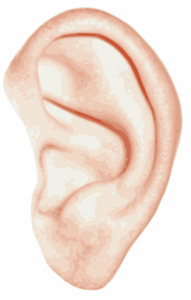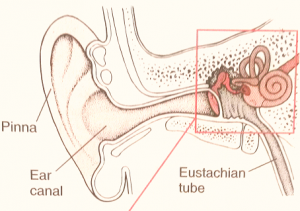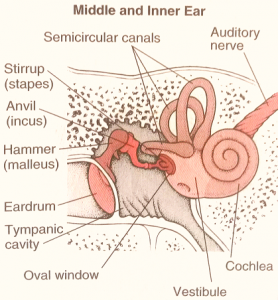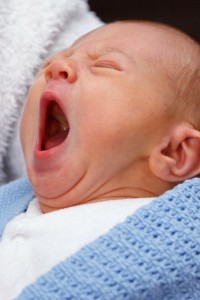Hi all
Are you ready to learn about, how does the ear function? Awesome. Before we get into the meat of the discussion, let’s have fun and learn some interesting facts about our wonderful ears!
- Exposure to extremely loud noise, around 85decibels can cause hearing loss!
- Sound travels at a speed of 1,130 feet per second, or 770 miles per hour
- The ear houses the smallest bone in the body, the stirrup(see diagram below)
The Human Ear
Essentially, the human ear is made up of 3parts,
1.The Outer Ear,
2.The Middle Ear,
3.The Inner Ear
It is amazing that an organ this size is responsible for our communication with the world. Let alone, it works constantly around the clock.
Did You Know?
That even whilst you sleep, your ear is hearing? Your brain chooses to shut the noise out. Cool! Don’t you think?
So exactly how does the ear function?
This article is going to take you through the process of how a person hears sound. From the point of entry of sound waves, to its pathway into the middle ear and finally its interpretation from the inner ear to the brain.
But first lets start off by chatting a little about the different parts of the ear.
The Outer ear
There are two parts that make up the outer ear,
a.The External Part: This is what we generally refer to as the ear lobe, medically its got its own fancy name, Pinna or Auricle
b.The Ear Canal
The lobe or pinna is cartilage covered with skin. The reason why our ears are shaped as such, is to capture the sound waves and to funnel it through the canal, up to the eardrum(or tympanic membrane).
Sorry for the jargon!!! Hope you still following me.
It is this membrane that separates the outer ear from the middle ear.
The Middle Ear
The three important parts to take note in the middle ear are
- The Eardrum,
- Air Filled Chamber(consisting of three specialised tiny bones, namely the hammer(malleus), anvil(incus) and stapes(stirrup). They got their wonderful names from the way they are shaped. Collectively, they are referred to as the ossicles. For simplicity, I will use this word….sheww! That is a relief.
- The Eustachian Tube
Right! the sound waves passes through the ear canal and is now at the entrance of the middle ear, the eardrum.
These sound vibrations are amplified mechanically by the ossicles and transmitted to the oval window, which is the entrance to the Inner ear.
Did You Know?
That the ossicles are are so small that they can be placed together on a penny.
Amazing! And just think that these tiny guys are responsible for tuning and protecting the ear, by controlling the response to loud noise and preventing damage to the inner ear.
The Eustachian tube is a small tube that connects the middle ear with the back of our nose allowing outside air to enter the middle ear.
When we swallow, this tube opens helping to maintain equal pressure on both sides of the eardum and prevents any fluid build-up in the middle ear.
What happens if the pressure is not equal?
The eardrum may bulge or retract, and the person may experience distorted hearing and it may feel uncomfortable.
This is the reason why we swallow or yawn, or chew, to voluntary “pop” our ears when we experience a change in altitude such as flying in an airplane- to relieve the uneven pressure.
When we get affected by a virus such as the common cold, the Eustachian tube gets blocked and inflamed. This can lead to middle ear infections, which affects the pressure and can cause pain.
In some cases, it can cause ringing in the ears, also called Tinnitus.If you are interested have a read through on this article, “Can sinus infection cause Tinnitus?”
The Inner Ear
Alrighty then, we are now onto the final part of the ear. The inner ear(or labyrinth)is made up of two major parts,
- The Cochlea- Organ of Hearing
- The Vestibular System – Determine position sense and helps to maintain balance
The cochlea, is the hollow coiled tube that is in a shape of a snail’s shell.
It is filled with fluid and has around 20 000 specialized hair cells.
Each of these hair cells have extensions called cilia, which extend into the fluid.
Are you all with me so far?
So, to recap!
Sound vibrations are transmitted from the ossicles in the middle ear to the oval window at the inner ear.
When these vibrations hit the oval window, its causes the fluid and the cilia to vibrate.
As I mentioned there are numerous hair cells. The interesting part is that hair cells in different parts of the cochlea vibrate to different sound frequencies.
The last part in the hearing sequence is, these hair cells that convert the vibrations into nerve impulses.
Where do these nerve impulses go to ? YOU GUESSED IT ……the BRAIN!!!
The nerve impulses are sent via the cochlea nerve to the brain for the interpretation of sound.
CONGRATS!!!!

You have just learned about the magnificent journey sound makes through your ear for you to understand, respond and enjoy.
!!WELL DONE!!
Fun Time
I have put in a video, extracted from Youtube, showing you the hearing process. It’s only a minute long.
How does loud noise cause hearing loss?
Good question. Now that you are well aware of, how does the ear function, this will be a piece of cake for you to understand.
Though the ossicles are responsible for regulating the sound entry, loud noise can still cause damage.
They can damage the hair cells and the scary part is, that once the hair cells are destroyed, they do not have the capability of regenerating.
The more the person is exposed to this loudness, the damage becomes more progressive. A Hearing test will reveal a mild, moderate or severe hearing loss depending on the exposure. The person will experience Tinnitus or ringing in the ears as a result.
Tip for Concert Lovers
For those of you who love to go for concerts, here is some advice to protect your ears from further insult. When you leave the arena or concert area, DO NOT GO BACK in.
Here’s why;
As you dancing and partying away, the loud noise causes your inner ear hair cells to drop down. (This explains why you feel numb when you leave a concert). When you leave to a quiet area, the hair cells slowly come back up.
Then when you decide to go back to rocking, it causes the hair cells to go back down. This is what can cause significant damage to these cells. So when you leave, leave the area for good and do not go back….
The ear helps for Balance, how does that work?
If you look at the diagram of the ear again, you will the semi-circular canals, as part of the inner ear.
They are filled with fluid and are positioned at right angles, to each other.
When you move your head, the fluid in these canals move too. Depending on the direction in which your head is moving, the fluid movement will be greater in one of the canals than in the others.
These canals also have hair cells that respond to this movement of fluid. These hair cells send nerve impulses to the brain, to tell it which way the head is moving so that the necessary action is taken to maintain balance.
What is VERTIGO?
Basically this is a whirling sensation, a feeling of disorientation. Malfunctioning of the semi-circular canals due to someone suffering from an upper respiratory infection for instance, causes them to loose their sense of balance.
Vertigo is a classic symptom of a condition called Meniere’s Disease. This is a condition whereby there is an imbalance in the fluids of the inner ear.
⇒Learn more about Meniere’s Disease here⇐
Conclusion
You have learnt the basics of how does the ear function. Its importance for hearing and balance. I have just touched on loud noise as a major culprit in causing hearing loss.
There are many other causes and I will chat about them in later articles. Do watch out for more information about tips on protecting your ears and common ear diseases and treatments.
I hope that you enjoyed this article. Please give it a share or like using one of your favourite social shares.
Let me know what your thoughts are and feel free to ask anything using the comment box below.
Till next time, take care.
Regards
Roopesh

It is so wonderful to know that our ears are so well adapted to pick up the vibration frequencies that make out the sound that we hear.
I work in a very noisy environment so I have to wear earplugs in order to block out most of the noise. Every time when I go to a concert, my ears will be ringing which is a clear indication that it is not that good to our ears.
Hello Viljoen
Agree with you 100%, our ears are truly amazing!!
If you are exposed to noise levels above 84db, on a regular basis at work, then you should have adequate protection for your ears.
The same goes for concerts, try to stay away as far from the speakers as possible and have your ear plugs with you.
Thanks for stopping by.
Roopesh
Roopesh,
There was a period of time when I was experiencing tinnitus, there was this constant ding in my right ear. At first, I didn’t notice it but then it became very uncomfortable when I couldn’t stop the “sound”. Thankfully for me, somehow it stopped after a while, but I definitively know how uncomfortable this little problem can cause.
I am glad your blog exist because I know it can help a lot of people who has tinnitus. It may not sound like the worst disease out there and may be hard to relate to to others but it’s most definitively unbearable at times.
Thank you.
Hello Anh
Thank heavens for you that the tinnitus or the ‘noise’ of yours went away.
I would like to reach to as many people as possible to help them with their Tinnitus and give them as much as support as I can, via this website.
Depending on the severity with which one gets his or her tinnitus, it can interfere with their productivity and way of living. This is what makes it challenging to treat.
Take Care
Roopesh
Hello, thanks for comprehensive article regarding ear anatomy.
Previously I knew how it works but after some years after college it is good to remember it again.
I wanted to check your videos. Maybe it is for me, but I do not see them.
Ears are really important part of our bodies. Overall, I think that everything is a must to have in our bodies.
I can not imagine how Beethoven created so beautiful music, when he was practically deaf.
I think that it is a miracle of Nature.
Anyway, we need to take of ourselves and cherish our health.
Thanks again, all the best, Nemira.
Hey Nemira
Thank you very much for reading my article.
Yes, Beethoven is an amazing composer. When you hear his music, you are reminded of his amazing brilliance.
Since we have only pair for life, its highly imperative that we do our very best to take care of our ears.
I know, I have learnt the hard way and will treasure my hearing now more than ever.
All of the best to you.
Regards
Roopesh
Hello Roopesh. I am glad you have a recap section here because I honestly would say I’m loaded with information, especially with the words.
It’s nice of you adding some cool images as well as a short video which is informative
It’s great of you understanding some viewers might get overloaded with insights like me.
By the way, it reminds me back in the old day where I learned Biology in high school.
Hello Tar
Yes, it can overwhelming with so much of info. I tried to make it as simple as possible.
Glad you got the gist of the article.
I remember those days of High School as well, those were the days.
Take Care
Roopesh